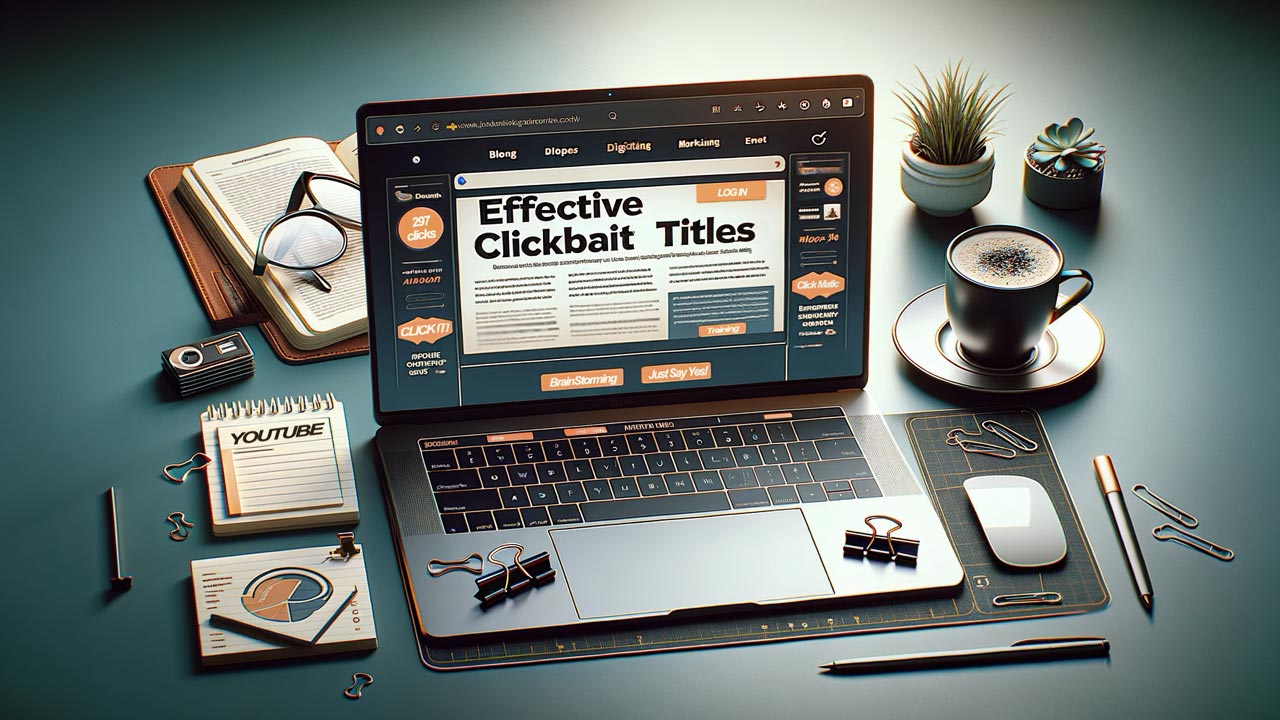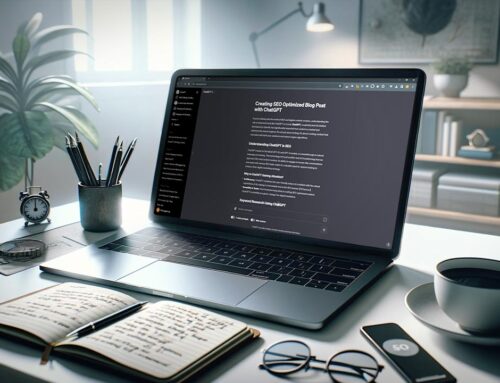When and How to Use Clickbait Titles
When it comes to digital marketing and content creation, mastering the art of clickbait titles is like walking a tightrope. It’s all about balancing the allure of a magnetic headline with the integrity of your content. In the ever-competitive landscape of online information, a well-crafted clickbait title can be your golden ticket to grabbing audience attention. Let’s dive into the world of clickbait titles and uncover when and how to use them effectively.
Key Takeaways
- Clickbait titles are essential in a competitive digital space for standing out.
- The effectiveness of a clickbait title lies in its ability to intrigue without misleading.
- Keywords and current trends can significantly enhance the appeal of a title.
- Ethical considerations are crucial to maintain credibility and trust.
- Clickbait strategies vary across different social media platforms.
Table of Contents
- Key Elements of Effective Clickbait Titles
- Techniques for Crafting Clickbait Titles
- Ethical Considerations in Clickbait
- Clickbait in Social Media
- Top 10 Frequently Asked Questions
- Conclusion
Key Elements of Effective Clickbait Titles
Incorporating Keywords
Using the right keywords in your clickbait titles is not just about SEO; it’s about connecting with your audience. Keywords should be relevant, targeted, and reflect what your audience is searching for. This ensures that your content does not just rank well but also resonates with the reader. Remember, the right keyword can make the difference between a title that is ignored and one that is clicked on. For in-depth strategies on keyword integration, visit 601 Media.
Leveraging Popular Trends
Clickbait titles that tap into current trends or popular culture can significantly boost engagement. By referencing trending topics, viral memes, or current events, you create a sense of immediacy and relevance. These titles capture the zeitgeist, making your content more relatable and timely. Combining SEO keywords with trends can create a powerful hook for your audience.
Being Controversial
Controversy sparks conversation and can drive significant traffic to your content. However, it’s crucial to handle controversial topics with care. The goal is to provoke thought and discussion, not to alienate or offend your audience. A well-executed controversial title can position you as a thought leader in your industry, but it requires a balance of boldness and sensitivity.
Creating a Sense of Urgency
Titles that convey a sense of urgency compel the reader to click, driven by a fear of missing out (FOMO). Phrases like “limited time offer,” “exclusive reveal,” or “urgent update” can create a compelling reason for immediate action. However, the content must match the urgency of the title to avoid disappointing readers.
Utilizing Numbers and Lists
Numbered lists and statistics in titles can be highly effective. They set clear expectations for the reader and suggest a structured, easy-to-digest format. For example, “7 Innovative Marketing Strategies You Haven’t Tried” gives readers a precise idea of what to expect while piquing their curiosity.
Crafting Intriguing Questions
Titles that pose intriguing questions engage the reader’s natural curiosity. Questions like “What Does the Future Hold for Cryptocurrency?” or “Why Are Influencers Turning to Sustainable Fashion?” draw readers in by promising answers to intriguing queries. These titles work best when the question is directly addressed and answered in the content.
Personalizing Titles
Personalized titles that speak directly to the reader can create a more intimate connection. Using “you” or “your” in titles makes the content feel tailored to the reader, increasing the likelihood of engagement. For example, “Improve Your Writing Skills with These Simple Tips” feels more direct and relevant to the individual reader.
Emphasizing Benefits
Titles that clearly articulate the benefits of reading the content can be highly effective. A title that promises a clear value, such as “Learn How to Save Money on Your Daily Commute,” is likely to attract readers interested in that specific benefit.
Techniques for Crafting Clickbait Titles
Using Teasers to Bulk Up Your Headlines
Teasers are a fantastic way to add intrigue to your headlines. They hint at something exciting or surprising within the article, encouraging readers to click through to discover the details. For example, “The Secret Ingredient Chefs Swear By – Number 5 Will Amaze You!” This technique not only piques curiosity but also promises a specific payoff, which can be a powerful motivator for readers.
List-Based Titles
List-based titles are incredibly popular because they provide clear, digestible content in an organized format. The key to a successful list title is to focus on the value each item brings. For instance, “Top 10 Life-Changing Apps for 2023” implies that each app mentioned in the list has the potential to significantly impact the reader’s life. Lists also offer a sense of completeness and authority, making your content more appealing.
Emotional Appeal
Titles that tap into the reader’s emotions can dramatically increase click-through rates. Whether it’s excitement, empathy, shock, or curiosity, an emotionally charged title resonates on a deeper level. For example, “The Heartwarming Story of How a Small Town Came Together to Save a Historic Landmark” is likely to attract readers looking for uplifting, feel-good content.
Piggybacking on Popular Culture
Leveraging well-known brands, celebrities, or events can significantly increase the appeal of your title. This technique, known as piggybacking, borrows interest from these popular entities. For example, “The Fitness Secrets of Hollywood’s Top Action Stars” uses the allure of celebrity fitness routines to attract readers.
Provocative Statements
Titles that make bold, provocative statements can be very effective in capturing attention. These titles often challenge conventional wisdom or offer counterintuitive perspectives. For example, “Why Everything You Know About Dieting Is Wrong” compels readers to click by promising a novel viewpoint on a familiar topic.
Hyperbole
Using hyperbole, or deliberate exaggeration, can be a useful technique in clickbait titles. It creates a sense of drama and urgency. However, it’s important to balance hyperbole with authenticity to avoid misleading readers. Titles like “The Most Incredible Vacation Destinations You’ve Never Heard Of” use hyperbole to create excitement while remaining grounded in reality.
Specificity and Details
Providing specific details in your title can make it more compelling and credible. For instance, “How I Boosted My Website Traffic by 300% in One Month” is more intriguing than a vague claim. The specificity lends authenticity and encourages readers to learn more about your successful strategy.
Using Questions and Mysteries
Creating a sense of mystery or posing a question can be highly effective. These types of titles prompt readers to seek the answer or resolution within your content. For example, “What Happens to Your Brain When You Drink Coffee Every Day?” incites curiosity about a common habit, inviting readers to explore the content for answers.
Ethical Considerations in Clickbait
Balancing Attraction with Honesty
The primary ethical consideration in clickbait is balancing the need to attract readers with the responsibility to be honest and transparent. Titles should be enticing but not at the cost of misleading the audience. For instance, a title promising “The Ultimate Solution to All Your Problems” is likely overpromising and could lead to reader disappointment and distrust. Ethical clickbait respects the reader’s expectations and time by delivering content that aligns with the promise of the title.
Avoiding Sensationalism
While sensational headlines can grab attention, they can also mislead and sensationalize serious topics. Ethical clickbait avoids exploiting sensitive issues for clicks. Titles should be crafted with a sense of social responsibility, especially when dealing with topics like health, politics, or personal well-being. The aim is to inform and engage, not to alarm or misinform.
Transparency in Sponsored Content
When dealing with sponsored content or advertisements, transparency is key. Clickbait titles used in this context should clearly indicate the promotional nature of the content. This approach not only adheres to ethical standards but also legal requirements in many regions. Readers should never feel tricked into viewing an ad or sponsored content.
Respecting the Audience’s Intelligence
Clickbait titles should respect the intelligence and discernment of the audience. Overusing hyperbolic or sensational phrases can insult the reader’s intelligence and damage the credibility of the content creator. Effective clickbait recognizes and respects the sophistication of the audience, offering them real value and reasons to engage with the content.
Consistency Between Title and Content
A key ethical aspect of clickbait is ensuring consistency between the title and the actual content. Clickbait becomes unethical when the content does not deliver on the title’s promise. It’s important that the body of the article fulfills the expectations set by the headline, providing the information, entertainment, or insights that the title suggests.
Reflecting True Content Value
The title should accurately reflect the value of the content. Exaggerated titles that promise life-changing revelations or miraculous solutions, but lead to mediocre or common knowledge content, are ethically questionable. Titles should be a genuine teaser of the content’s value, encouraging clicks based on real, tangible insights or information offered.
Cultural Sensitivity and Inclusivity
In crafting clickbait titles, cultural sensitivity and inclusivity should be considered. Titles should not perpetuate stereotypes, biases, or offensive generalizations. Ethical clickbait is inclusive, considers diverse perspectives, and avoids alienating or offending different groups of people.
Long-Term Trust vs. Short-Term Clicks
Finally, ethical clickbait focuses on building long-term trust with the audience rather than just generating short-term clicks. This involves a commitment to quality content and honest communication, recognizing that reader trust is more valuable in the long run than temporary spikes in traffic.
Clickbait in Social Media
Understanding Platform Dynamics
Each social media platform has its unique dynamics and audience preferences, which must be considered when crafting clickbait titles. For instance, what works on Instagram may not be as effective on LinkedIn. Instagram’s visual focus might favor image-driven clickbait, while LinkedIn’s professional environment might respond better to industry-related headlines. It’s crucial to tailor your clickbait strategy to suit the platform and its audience.
Visual Clickbait on Image-Heavy Platforms
Platforms like Instagram and Pinterest rely heavily on visuals. Here, clickbait extends beyond just the title to include captivating images or graphics. The combination of a striking image with an intriguing title can be particularly effective. For example, a visually appealing photo with a caption like “The Secret to Perfect Travel Photos Revealed” can drive significant engagement.
Video Titles and Thumbnails
On platforms like YouTube and TikTok, video titles and thumbnails serve as clickbait. The key is to create thumbnails and titles that are intriguing but accurate representations of the video content. Misleading thumbnails or titles can lead to viewer dissatisfaction and harm your channel’s credibility.
Leveraging Hashtags and Trends
Social media clickbait can also leverage popular hashtags and trends to increase visibility and engagement. However, it’s important to ensure that your content is relevant to the hashtags or trends you are using. Irrelevant or misleading use of trending hashtags can backfire and damage your brand’s reputation.
Crafting Share-Worthy Titles
Social media thrives on shareability. Clickbait titles on social media should not only encourage clicks but also be compelling enough for users to share with their network. Titles that evoke emotion, surprise, or curiosity are more likely to be shared.
Responsiveness and Interaction
Engaging with your audience in the comments or through direct messages can also be a form of clickbait. Encouraging questions or discussions in your post and actively participating can increase engagement and keep your audience invested.
Ethical Considerations
As with other forms of clickbait, it’s important to maintain ethical standards on social media. This includes being truthful, respecting the intelligence of your audience, and avoiding exploitation of sensitive topics for clicks.
Analytics and Adjustments
Utilizing social media analytics tools to track the performance of your clickbait titles can provide valuable insights. These insights can guide adjustments and refinements in your strategy to better engage with your audience and achieve desired outcomes.
Top 10 Frequently Asked Questions
Conclusion
Clickbait titles, when used responsibly, can be a powerful tool in your content marketing arsenal. They can help your content stand out, attract more viewers, and potentially increase engagement. The key is to balance the allure of a catchy headline with the integrity and value of your content.









Leave A Comment